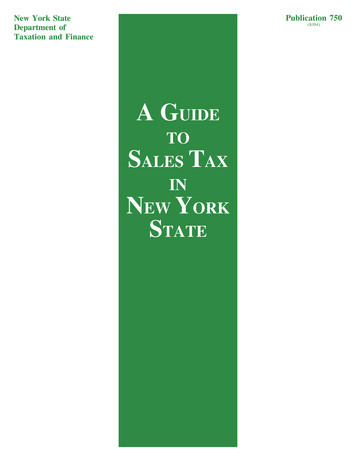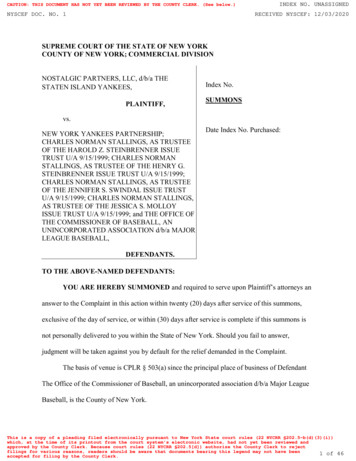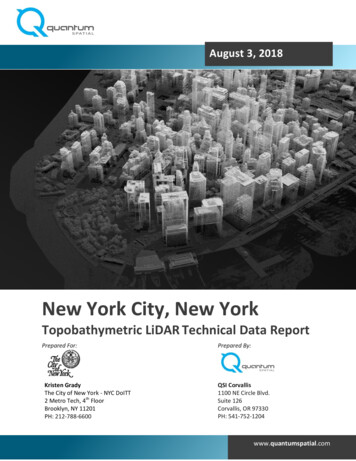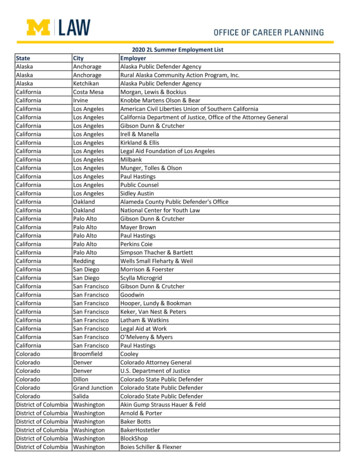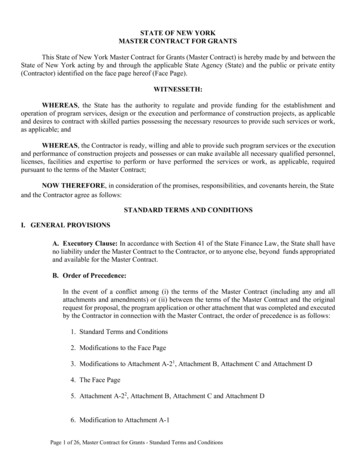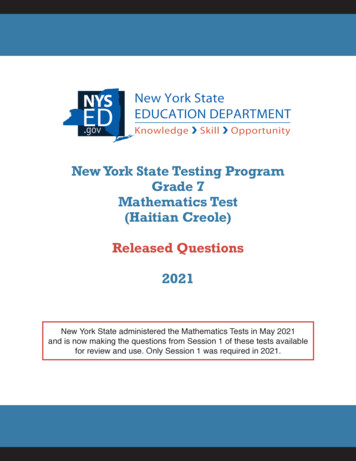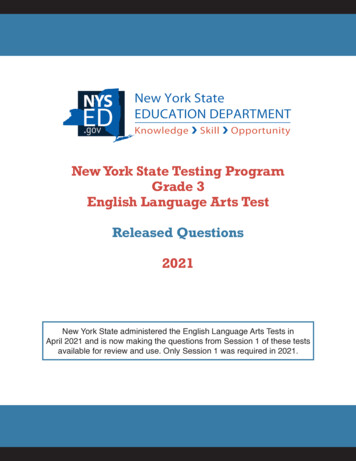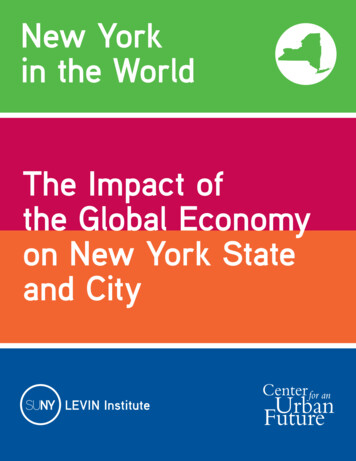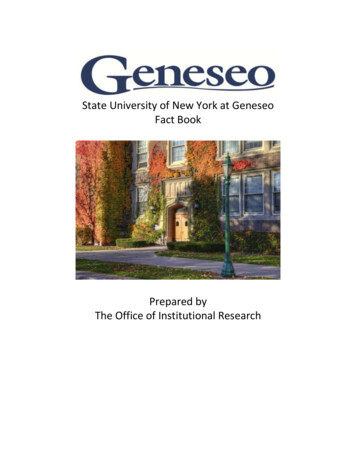
Transcription
State University of New York at GeneseoFact BookPrepared byThe Office of Institutional Research
State University of New York at GeneseoFact BookINTRODUCTIONThis Fact Book was created by the Office of Institutional Research to answer frequentlyasked questions concerning SUNY Geneseo. The information included represents the2011-2012 academic year.Unless otherwise indicated, data for all tables were extracted from the census data (i.e.,Early Student Data Submission) for the appropriate academic year and term.Consequently, the Fact Book is updated at the end of each spring term. An electronic copycan be found at http://www.geneseo.edu/ir.The Office of Institutional Research wishes to thank all members of the college communitywho assisted in the production of the Fact Book by providing data, suggesting changes, andpreparing tables. Please contact Julie Rao (rao@geneseo.edu) at 585-245-5553 with anyfeedback or questions.Prepared by the Office of Institutional Research
State University of New York at GeneseoFact BookTABLE OF CONTENTSINTRODUCTION .TABLE OF CONTENTS .COLLEGE PROFILE . 1HISTORY OF GENESEO . 2MISSIONS, VALUES AND GOALS . 4STATEMENT ON DIVERSITY AND COMMUNITY . 5OFFICERS OF THE COLLEGE . 6BOARD OF TRUSTEES . 7COLLEGE COUNCIL AT GENESEO . 8REFERENCE CHRONOLOGY . 9CAMPUS MAP . 11CHRONOLOGY OF CAMPUS BUILDINGS . 12LIBRARY . 16TECHNOLOGY . 19STUDENTS. 20APPLICATIONS, ADMISSIONS AND REGISTRATIONS . 21FRESHMAN CLASS ACADEMIC PROFILES . 23ETHNIC BACKGROUND OF FIRST TIME, FULL TIME STUDENTS. 25ETHNIC BACKGROUND OF FULL TIME STUDENTS . 26FALL ENROLLMENT . 27GEOGRAPHIC ORIGINS . 28UNDERGRADUATE MAJORS AND PRE-MAJORS . 29UNDERGRADUATE MINORS . 30TRENDS IN MAJOR DEMOGRAPHICS . 32FALL 2011 MAJORS BY ETHNICITY . 33BACHELORS DEGREES CONFERRED BY PROGRAM . 34MASTERS DEGREES CONFERRED BY PROGRAM . 36RETENTION AMONG FIRST TIME, FULL TIME STUDENTS . 37GRADUATE ENROLLMENT BY PROGRAM . 38GRADUATION AND RETENTION RATES. 39GRADUATION RATES BY PROGRAM . 40GRADUATION RATES BY PROGRAM ETHNICITY . 44GRADUATION RATES BY PROGRAM BY GENDER . 48ENROLLMENT AND GRADUATION HISTORY . 52FACULTY AND STAFF. 53ETHNICITY OF FULL TIME FACULTY . 54ETHNICITY OF PART TIME FACULTY . 55ETHNICITY OF EMPLOYEES . 56FACULTY BY RANK BY DEPARTMENT . 58GENDER OF FACULTY BY DEPARTMENT . 59SOURCE OF HIGHEST DEGREE OF FULL TIME FACULTY . 60FACULTY/STAFF AWARDS . 62FINANCES . 72Prepared by the Office of Institutional Research
State University of New York at GeneseoFact BookANNUAL TUITION AND FEES . 73CURRENT FUNDS- REVENUES . 74CURRENT FUNDS- EXPENDITURES AND TRANSFERS . 75ALUMNI . 76ALUMNI EXECUTIVE COMMITTEE . 77ALUMNI DIRECTORS . 78UNDERGRADUATE ALUMNI ALLIANCE EXECUTIVE COUNCIL . 80GENESEO ALUMNI ASSOCIATION AWARDS. 81BACCALAUREATE-ORIGINS OF US RESEARCH DOCTORATES RECIPIENTS- MASTERS &UNDERGRADUATE INSTITUTIONS 2000-2009. . 85BACCALAUREATE-ORIGINS OF US RESEARCH STEM DOCTORATES RECIPIENTS- MASTERSINSTITUTIONS 2000-2009. . 86BACCALAUREATE-ORIGINS OF US RESEARCH STEM DOCTORATES RECIPIENTSUNDERGRADUATE INSTITUTIONS 2000-2009. . 87Prepared by the Office of Institutional Research
State University of New York at GeneseoFact BookCOLLEGE PROFILEPrepared by the Office of Institutional ResearchPage 1
State University of New York at GeneseoFact BookHISTORY OF GENESEOSUNY Geneseo, one of thirteen university colleges within the State University of New Yorksystem, was established by an act of the New York State Legislature in 1867 as theWadsworth Normal and Training School. In August 1871 the Legislature changed the nameto the Geneseo Normal and Training School and officially opened September 13, 1871.Curricular offerings included elementary English, advanced English, and classical studies.In the early 1900’s, the curriculum was reorganized to require two years of professionalstudy, and admission was restricted to high school graduates. In 1922, the programs wereextended to three years, and in 1938, to four years. In 1942, the College was grantedauthority to confer baccalaureate degrees in all its curricula. Basic teacher trainingprograms were expanded to include preparations for teacher-librarians, teachers ofchildren with special needs, and speech pathologists. Teacher education continues to be astrong component of the College’s programs.Geneseo became an original campus of the new State University of New York (SUNY)system at SUNY’s inception in 1948. During the next three decades the College developedstrong liberal arts and sciences programs and added several professional curricula to itsofferings. The first master’s degrees were awarded in 1951. In 1962, the teachers collegesof the State University became Colleges of Arts and Sciences. Geneseo’s four-year degreeprograms in arts and sciences were implemented in 1964. Since then, the School ofBusiness was established and majors have been added in such areas as biochemistry,geophysics, and international relations. The College now offers more than 50 degreeprograms in a wide variety of disciplines. Cooperative programs have been developed inseveral fields with other institutions, including 3-2 engineering, 3-4 dental, and 3-2 and 4-1MBA programs. The College’s commitment to providing a broad-based liberal artseducation was confirmed in 1980 with the institution of a required core curriculum innatural sciences and mathematics, social sciences, humanities, and fine arts. Furtherrevision in 1999 added critical writing, a quantitative requirement and foreign language.The College continues to improve and upgrade its curriculum through regular review andassessment. The strength of the liberal arts program was recognized in 2003 with approvalfor the installation of a Phi Beta Kappa chapter on campus. The chapter inducted its firstclass in spring, 2004.Since 1994, SUNY Geneseo has been a member of the Council of Public Liberal ArtsColleges (COPLAC), an alliance of high quality, public liberal arts institutions. Found in 1987,COPLAC serves to promote excellent undergraduate education in the liberal arts tradition;the development of effective teaching and learning communities; and the expansion ofaccess to public undergraduate liberal arts education of the highest caliber. COPLAC’smembership currently consists of twenty-five public liberal arts colleges and universitieswho are committed to providing and advocating for the superlative, life-enhancingundergraduate education normally associated with small independentPrepared by the Office of Institutional ResearchPage 2
State University of New York at GeneseoFact BookHISTORY OF GENESEOcolleges. COPLAC also provides leadership in defining and modeling “best practice” inundergraduate education and promoting the qualities cultivated by outstanding studentcentered liberal arts colleges.The State University of New York at Geneseo has evolved dramatically over its 142-yearhistory into a highly selective public liberal arts college, which is nationally recognized forthe quality of education it offers.Prepared by the Office of Institutional ResearchPage 3
State University of New York at GeneseoFact BookMISSIONS, VALUES AND GOALSMission StatementSUNY Geneseo, nationally recognized as a center of excellence in undergraduateeducation, is a public liberal arts college with selected professional and master's levelprograms. It combines a rigorous curriculum and a rich co-curricular life to create alearning-centered environment. The entire college community works together to developsocially responsible citizens with skills and values important to the pursuit of an enrichedlife and success in the world.Values Excellence, and upholds high standards for intellectual inquiry and scholarlyachievement;Innovation, and affirms a spirit of exploration that fosters continued excellence;Community, and embraces the educational aspirations and interests that itsmembers share;Diversity, and respects the unique contributions of each individual to the campuscommunity;Integrity, and promotes the development of ethical citizens;Service to Society, and models the qualities it seeks to develop in its students;Tradition, and celebrates its long history of collaborative, learning-centerededucation.Planning Goals Provide every student the highest quality education through a rigorous, challenging,and active learning experience in close working relationships with faculty and staffthat encourages intellectual engagement and personal growth.Recruit, support, and foster the development of a diverse community ofoutstanding students, faculty, and staff.Enrich the collegiate experience by strengthening the integration betweencurricular and co-curricular programs.Cultivate relationships between the College and wider community that supportCollege programs and serve the community.Expand funding for institutional priorities and initiatives through public and privatesupport, grants, and entrepreneurial activities.Promote institutional effectiveness through ongoing assessment in every program.Provide a high quality physical environment and outstanding services, facilities,equipment, and technology.Prepared by the Office of Institutional ResearchPage 4
State University of New York at GeneseoFact BookSTATEMENT ON DIVERSITY AND COMMUNITYGeneseo Statement on Diversity and CommunityGeneseo holds among its core values the ideals of community and diversity. Ourcommunity is defined as a group of faculty, students and staff who live and work togetherat Geneseo because they share common goals that are based on the ideals of highereducation rooted in the liberal arts.Although they share common goals, the members of the Geneseo community also differ inmany ways. Diversity at Geneseo is defined in part as differences in individuals that aremanifested in their race, ethnicity, national origin, language heritage, world-view, religion,gender, sexual orientation, class, physical ability, learning style, geographic background,mental health, age, and relationship status.Geneseo recognizes that the individuals who make up our community bring to it uniqueperspectives and knowledge that contribute to its richness and vibrancy. Because Geneseoalso holds educational excellence among its core value, it recognizes that its progress as acommunity toward such excellence is predicated on its ability to embrace both thediversity of its members and the vigorous exchange of their ideas.Geneseo calls all members of our community to share responsibility for the ongoing workof continually recreating a sense of inclusion, belonging, and empowerment, so thattogether we will achieve our individual and collective aims, and experience the intellectualliberation that is at the heart of the educational enterprise.Endorsed by the College Senate and Approved by the President, September 2003.Prepared by the Office of Institutional ResearchPage 5
State University of New York at GeneseoFact BookOFFICERS OF THE COLLEGEPresidentProvostVice President for College AdvancementVice President for Administration & FinanceVice President for Student & Campus LifeAssociate Vice President for Enrollment ServicesExecutive Assistant to the PresidentChristopher C. DahlCarol S. LongMichael J. CatillazJim B. MilroyRobert A. BonfiglioWilliam L. CarenBecky L. GlassDepartment Chairs & DeansDean of the CollegeSavitri IyerAnthropologyArts (History)Arts (Studio)BiologyBusiness, School ofChemistryCommunicationCommunicative Disorders & SciencesComputer ScienceEducationEnglishGeographyGeological SciencesHistoryLanguages ical SciencePsychologySociologyTheatre & DanceRose-Marie ChiericiSavitri IyerDan DeZarnGeorge BriggsMichael SchinskiDavid JohnsonAndrew HermanLinda HouseChristian ShinJames GarofaloPaul SchachtDavid RobertsonScott GiorgisJoseph CopeRosemary McEwenChristopher LearyJonathan GonderCarlo FiliceCharles FreemanJeffrey KochGanie DeHartKurt CylkeSteven StubblefieldPrepared by the Office of Institutional ResearchPage 6
State University of New York at GeneseoFact BookBOARD OF TRUSTEESFor the State University of New York (SUNY)Chair: H. Carl McCall, New York, NY (2014)Joseph Belluck, New York, NY (2017)Kaitlyn Beachner, Buffalo, NY (2012)Tina Good, Long Island, NY (2016)Ronald G. Ehrenberg, Ithaca, NY (2013)Stephen J. Hunt, Katonah, New York (2013)Eunice A. Lewin, Buffalo, NY (2016)Marshall A. Lichtman, Rochester, NY (2011)John L. Murad, Jr., Syracuse, NY (2013)Pedro Antonio Noguera, New York, NY (2015)Kenneth P. O’Brien, Albany, NY (2011)Linda S. Sanford, Somers, NY (2014)Carl Spielvogel, New York, NY (2015)Cary F. Staller, Hauppauge, NY (2015)Gerri Warren-Merrick, New York, NY (2012)Note: Year each trustee’s term ends provided in parenthesisPrepared by the Office of Institutional ResearchPage 7
State University of New York at GeneseoFact BookCOLLEGE COUNCIL AT GENESEOThe College Council serves as an advisory board to Geneseo’s senior administration,providing valuable assistance in problem-solving and identifying sources of expertisebeyond the campus community. They also advocate for the College in a variety of ways.College Council members are appointed by the Governor. The current members are:Rev. Dr. Iris BanisterGov. ApptRochesterBegan 2008 – 2015 Term EndsMr. Christian N. Valentino, Esq Gov. ApptWebsterBegan 2008 – 2014 Term EndsDr. Robert A. HeinemanGov. ApptAlfredBegan 1998 – 2011 Term EndsMr. J. Michael SeeleyRochesterBegan 2010 – 2013 Term EndsDr. A. Gidget HopfGov. ApptGeneseoBegan 2008 – 2010 Term EndsMr. Robert D. Wayland-Smith (Chair)PittsfordGov. ApptBegan 1999 – 2011 Term EndsDr. Judith HunterGov. ApptGeneseo, NY 14454Began 2010 – 2017 Term EndsMr. Eddie LeeGeneseo, NY 144Ms. Mary LuckernGov. ApptGenevaBegan 2008 – 2012 Term EndsDr. Dennis ShowersChair, College SenateSchool of EducationMr. Nick SpenglerGeneseo, NY 14454Gov. Appt(Alumni Rep.non-voting)FacultyRep.(StudentRep. non-voting)Prepared by the Office of Institutional ResearchPage 8
State University of New York at GeneseoFact BookREFERENCE CHRONOLOGYChief Executive OfficersPrincipals:1. William J. Milne2. John M. MilneHubert J. Schmitz3. James V. Sturges4. Winfield A. Holcomb5. James B. WellesPresidents:6.7.8.9.Herbert G. EspyKenneth H. FreemanFrancis J. MoenchRobert W. MacVittie10. Edward B. Jakubauskas11. Carol C. Harter12. Christopher C. Dahl1871-18891889-19051903-1905 (Acting forJohn M. 4 (Acting)1954-19631963-19791988-1989 (Interim)1979-19881989-19951995-Major Milestones1867 Wadsworth Normal and Training School - Established by New York Legislature1871 First students enroll; Name changed to Geneseo Normal and Training School;Programs offered in Elementary English (two-year program), advanced English(three-year program) and classical (four-year program)1905 Name changed to Geneseo Normal School; all curricula reduced to two-yearprograms; admission limited to graduates of approved four-year high schools1910 Program for Teacher-Librarians added1914 Summer Sessions introduced for in-service teachers1921 Programs introduced for teachers of mentally handicapped1922 Programs extended to three-year duration1936 Received 45 acres, courtesy of Geneseo School District1938 Programs extended to four-year duration1940 Bachelor of Science in Education first conferred on teacher-librarians1942 Bachelor of Science in Education extended to all degree programs1945 Program for “speech correctionists” in public schools introduced1948 State University of New York created; institutional name changed to StateUniversity Teachers College at Geneseo, authority granted to confer Master ofScience in Education degree1951 First Master's degree conferred; Program in Speech Education introduced1952 First accreditation by Middle States Association; Name changed to State UniversityCollege of Education at GeneseoPrepared by the Office of Institutional ResearchPage 9
State University of New York at GeneseoFact BookREFERENCE CHRONOLOGY1960 Program introduced for preparing teachers of the Speech and Hearing Handicapped1961 Authority granted to prepare teachers of English and social studies1962 Name changed to State University College at Geneseo; authority granted to offerB.A. and B.S. programs in the arts and science to two-year transfer students;authority granted to prepare teachers in mathematics and science1964 Full four-year programs introduced in arts and sciences1965 Authority granted to prepare teachers of modern foreign languages1970 Three-two engineering program established with SUNY Buffalo1971 Innovative three-year bachelor's degree program introduced1979 Reading and Early Childhood Education options added to Education programs;Holcomb Campus School closed1980 John Wiley Jones School of Business founded, incorporating programs inManagement Science, Accounting, and Economics1983 B.A. program in Computer Science and B.S. program in Biochemistry introduced;School of Library and Information Science closed1988 Management Information Systems introduced1991 Department of Health and Physical Education discontinued; Teacher educationprograms consolidated into School of Education; Three-year bachelor's degreeprogram concluded1993 Management Information Systems program discontinued; Biophysics majorintroduced1994 Departments of Music and Theater merged to create School of Performing Arts1994 College becomes a member of the Council of Public Liberal Arts Colleges (COPLAC)1995 Department of Speech Pathology & Audiology name changed to CommunicativeDisorders & Sciences1995 Campus House purchased by Campus Auxiliary Services1998 Big Tree Inn purchased by Campus Auxiliary Services; the School of Education namechanged to Ella Cline Shear School of Education2000 Geneseo Foundation purchased the former St. Mary’s Parish Center at 26 MainStreet to create a new college/community art gallery; groundbreaking ceremonywas held for a new townhouse-style residential complex2001 College purchased land at 4 and 6 Park Street and created a parking lot and roadconnecting Park Street and School Street2002 Accreditation by the Association to Advanced Collegiate Schools of Business(AACSB)2004 Installation of the Alpha Delta Chapter of Phi Beta Kappa2005 Merged School of Performing Arts and Art Department to form School of Arts2007 Ella Cline Shear School of Education accredited by the National Council for theAccreditation of Teacher Education (NCATE)Prepared by the Office of Institutional ResearchPage 10
State University of New York at GeneseoFact BookCAMPUS MAPPrepared by the Office of Institutional ResearchPage 11
State University of New York at GeneseoFact BookCHRONOLOGY OF CAMPUS 95119531955195519551958195919601961BUILDINGOld MainNormal HallTraining School AddedGymnasium and Science HallPurchase of Kelsey FieldLibrary and Swimming PoolKillup House becomes Elizabeth Wadsworth Nursing HomeWelles Academic Building (former Holcomb Building)Named in honor of Dr. James B. Welles, Principal of Geneseo Normalfrom 1934 to 1946.Sturges Academic BuildingNamed in honor of Dr. James V. Sturges, Principal of Geneseo Normalfrom 1905 to 1922.Blake Academic Building - A, B, C, D, ENamed in honor of Anne S. Blake, who was hired as a substitutekindergarten teacher in Geneseo Normal School's School of Practicein 1917, became head of the kindergarten department in 1918, andserved as Dean of Women from 1921 until her retirement in 1934.Heating Plant Service BuildingFraser Academic BuildingNamed in honor of Bertha Paine Fraser, one of the first two womenappointed to Geneseo Normal's Board of Visitors (precursor of theCollege Council). She served on the Board from 1917 to 1947.President's House (15 Main Street),Built in 1896, was acquired by the CollegeWadsworth AuditoriumNamed in honor of all members of the Wadsworth family who playeda role in the College's history.Jones Residence HallNamed in honor of Lydia I. Jones (1878-1958), who joined the NormalSchool as an English teacher in 1904, served as the first Dean ofWomen from 1912 to 1922 (apparently under the title Preceptress ofGirls for at least part of her tenure), and also chaired the EnglishDepartment from 1919 until her retirement in 1922.Livingston Residence Hall*Mary Jemison Dining HallNamed in honor of Mary Jemison (1742-1833), a white women wholived as one of the Senecas after being kidnapped by them as a child.Monroe Residence Hall*Prepared by the Office of Institutional ResearchPage 12
State University of New York at GeneseoFact BookCHRONOLOGY OF CAMPUS 966196619671967Schrader Health and Physical EducationNamed in honor of Carl L. Schrader (1872-1961), physical traininginstructor at Geneseo Normal School from 1900 to 1905. Schraderestablished the Normal's basketball team and coached several otherteams.Transformer Service BuildingBailey Science BuildingNamed in honor of Guy Bailey (1874-1946) (the building is officiallynamed Guy A. Bailey), who was hired to teach biology and physicalgeography at Geneseo Normal School in 1905, was named head ofthe science department in 1924, and retired in 1939.Steuben Residence Hall*Genesee Residence Hall*Letchworth Dining HallNamed in honor of William Pryor Letchworth (1823-1910), a WesternNew York businessman and philanthropist whose interests includedNative American archaeology, the fine arts, and care of epileptics, thementally ill, and the poor.Ontario Residence Hall*Wyoming Residence Hall*Allegany Residence Hall*Erie Residence Hall*Lauderdale Health CenterNamed in honor of two Geneseo physicians: Dr. Walter Lauderdale,Sr. (1806-1893), who was a member of Geneseo Normal School'soriginal Board of Visitors and served from 1871 to 1893, and his son,Dr. Walter Lauderdale, Jr. (1850-1933), who served on the Board ofVisitors from 1894 to 1933.Milne LibraryNamed in honor of Geneseo Normal School's first two principals: Dr.William J. Milne, who served from 1871 to 1889; and his brother, Dr.John M. Milne, who served from 1889 to 1905.Brodie Fine ArtsNamed in honor of William A. Brodie, a Geneseo attorney whoseclients included various members of the Wadsworth family. Brodiewas one of several local leaders whose efforts were instrumental ingetting a Normal School located in Geneseo.Clark Service BuildingNamed in honor of L. Watson Clark, who served as janitor and chiefcustodian from 1914 until his retirement in 1949.Prepared by the Office of Institutional ResearchPage 13
State University of New York at GeneseoFact BookCHRONOLOGY OF CAMPUS 9701973199519951997Erwin AdministrationNamed in honor of Austin W. Erwin, a 1909 Geneseo Normal Schoolgraduate who served as Geneseo Town Supervisor, Livingston CountyDistrict Attorney, and New York State Senator (1944-1963).Nassau Residence Hall*Newton Lecture HallNamed in honor of George D. Newton, a local attorney who served asGeneseo Justice of the Peace, Livingston County District Attorney,State Supreme Court Justice (beginning in 1962 and apparently until1965), and member and president of the Board of Visitors andCollege Council beginning in 1942.Red Jacket Dining HallNamed in honor of Red Jacket (ca. 1758-1830), Seneca chief andorator who opposed the sale of Western New York Indian land to thewhites in the late 1700s.Suffolk Residence Hall*MacVittie College UnionNamed in honor of Dr. Robert W. MacVittie, President from 1963-71and 1972-79 (he left briefly when he accepted the presidency of thenew SUNY upper-division college at Utica-Rome) and InterimPresident from 1988 to 1989.Holcomb Learning CenterNamed in honor of Dr. Winfield A. Holcomb, Principal of GeneseoNormal from 1922 to 1934.Greene Science BuildingNamed in honor of Robert A. Greene, who was appointed to GeneseoNormal's science faculty in 1916, left briefly for World War I militaryservice, and served as Chair of the Science Department until hisretirement in 1954. Upon his retirement, Greene was the firstrecipient of the College's Distinguished Service Award.Niagara Residence Hall*Wayne Residence Hall*Onondaga Residence Hall*Alumni Field HouseSouth HallCampus House (17 Main Street)Built in 1816, acquired by Campus Auxiliary ServicesRoemer House (11 Bank Street)Purchased by the College.Named in honor of Dr. Spencer J. Roemer, Director of AdmissionsEmeritus and college benefactor.Prepared by the Office of Institutional ResearchPage 14
State University of New York at GeneseoFact BookCHRONOLOGY OF CAMPUS ig Tree Inn (46 Main Street),Built in 1832, obtained by CAS.McClellan House/Lockhart Gallery (26 Main Street),Built in 1825, purchased by the College.Saratoga Terrace* (Townhouses)Putnam Hall*Merritt Athletic Center (formerly known as Alumni Field House)Integrated Science
State University of New York at Geneseo Fact Book Prepared by the Office of Institutional Research Page 4 MISSIONS, VALUES AND GOALS Mission Statement SUNY Geneseo, nationally recognized as a center of excellence in undergraduate education, is a public liberal arts college with s



